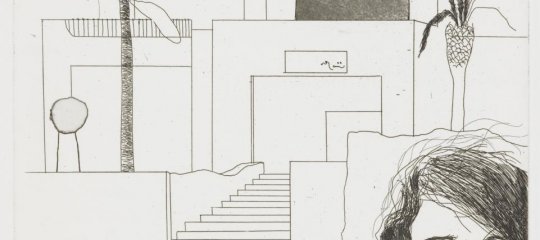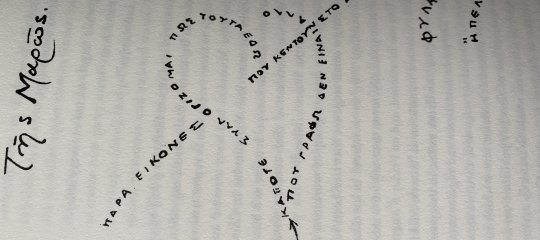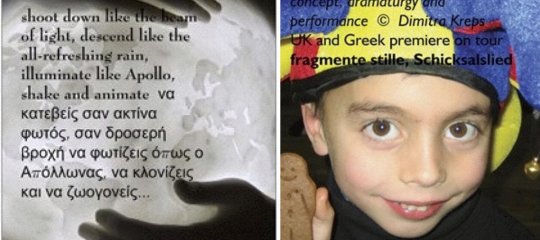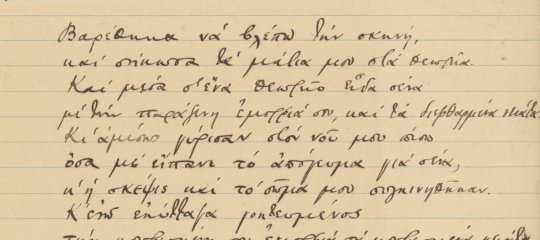Η ΑΞΙΑ ΤΗΣ ΜΕΛΟΠΟΙΗΜΕΝΗΣ ΠΟΙΗΣΗΣ
Συγχαρητήρια στην κ. Αθανασοπούλου για την πραγματοποίηση του κύκλου διαλέξεων της ελληνικής μελοποιημένης ποίησης. Η διδασκαλία της μελοποιημένης ποίησης μπορεί πραγματικά να γοητεύσει τους σπουδαστές της ελληνικής γλώσσας, ακριβώς γιατί εμπεριέχει το στοιχείο της γλώσσας, της ποίησης και της μουσικής σε ένα αρμονικό σύνολο και τελικό αποτέλεσμα. Στο παρελθόν είχα αφιερώσει έναν κύκλο μαθημάτων στη μελοποιημένη ποίηση στο Κέντρο Ελληνικού Πολιτισμού Μόσχας και περιστασιακά τη χρησιμοποιώ συνέχεια, όπως είμαι σίγουρος ότι κάνουν και άλλοι συνάδερφοι. Θεωρώ ότι η θετική αποτίμηση της συνεισφοράς της μελοποιημένης ποίησης στη διδασκαλία των Ελληνικών θα πρέπει κάπως να μεταφραστεί και σε μια πιο ενεργή προβολή της αξίας της, ενδεχομένως και με την παροχή υλικού (στίχοι - μουσική) μέσα από τους ελληνικούς εκπαιδευτικούς ιστότοπους, όπως η Πύλη της Ελληνικής Γλώσσας, αν και, αναγνωρίζω πως για το σκέλος της μουσικής υπάρχει πάντα το πρόβλημα των δικαιωμάτων δισκογραφικών εταιρειών, δημιουργών κ.λπ. Το ίδιο πρόβλημα υπάρχει και για τις κινηματογραφικές ταινίες, γι' αυτό πιστεύω πως η λύση θα πρέπει να είναι πολιτική, δηλαδή η ηγεσία του Υπουργείου Παιδείας να πάρει τη γενναία απόφαση να αγοράσει δικαιώματα υλικού (μουσική, ταινίες, ντοκιμαντέρ) που μπορεί να έχει ύψιστη παιδευτική αξία στην υπόθεση της διδασκαλίας της ελληνικής γλώσσας και πολιτισμού και στη συνέχεια να παρέχει το υλικό αυτό μέσω διαδικτύου. Στο υλικό θα μπορεί, ενδεχομένως, να υπάρχει ελεγχόμενη πρόσβαση.
Επανερχόμενος στο ζήτημα της μελοποιημένης ποίησης, θεωρώ πως συνθέτες, όπως ο Θεοδωράκης, ο Δήμος Μούτσης, ο Χρήστος Λεοντής, ο Θάνος Μικρούτσικος κ.α. που μελοποίησαν Ελύτη, Σεφέρη, Καβάφη, Ρίτσο, Καρυωτάκη, Καββαδία κ.α. θα πρέπει να υπάρχουν απαραιτήτως στη δισκοθήκη κάθε εκπαιδευτικού. Πιστεύω πως το φαινόμενο μελοποιημένη ποίηση αποτελεί πλέον συστατικό στοιχείο της νεοελληνικής ταυτότητας, στη διαμόρφωση της οποίας, οι εν λόγω συνθέτες, συντέλεσαν τα μέγιστα. Ας σκεφτούμε, μόνο, πόσες γενιές και γενιές μαθητών έχουν τραγουδήσει το "Ένα το Χελιδόνι" του Θεοδωράκη ή "Το μαχαίρι" του Μικρούτσικου. Ο καθαρός, γνήσιος νεοελληνικός χαρακτήρας αυτών των τραγουδιών - ποιημάτων συγκινεί κάθε ξένο ελληνιστή και η αναγνώριση αυτού του γεγονότος θα πρέπει να αποτελέσει το μεγάλο μας όπλο (μαζί με άλλες πτυχές του νεοελληνικού βίου) στη διάδοση της νεοελληνικής γλώσσας και πολιτισμού στο εξωτερικό, ξεπερνώντας τη "σκιά" του αρχαιοελληνικού παρελθόντος. Για τη γενικότερη αξία του νεοελληνικού, σύγχρονου τραγουδιού επισημαίνω εδώ απλά πως οι περισσότεροι Ρώσοι φοιτητές - μαθητές μου έχουν ως ηχητικά σήματα κλήσης στα κινητά τους μελωδίες ελληνικής μουσικής, ακούν δε μανιωδώς από Χαρούλα Αλεξίου ως Λαυρέντη Μαχαιρίτσα, για να δώσω ενδεικτικά δύο παραδείγματα. Επομένως αξίζει, νομίζω, να γίνει μια συστηματική προσπάθεια ερμηνείας αυτού του φαινομένου αλλά και αξιοποίησης αυτού του σημαντικότατου κεφαλαίου, που λέγεται μελοποιημένη ποίηση και ελληνικό τραγούδι.
- Εισέλθετε στο σύστημα για να υποβάλετε σχόλια











